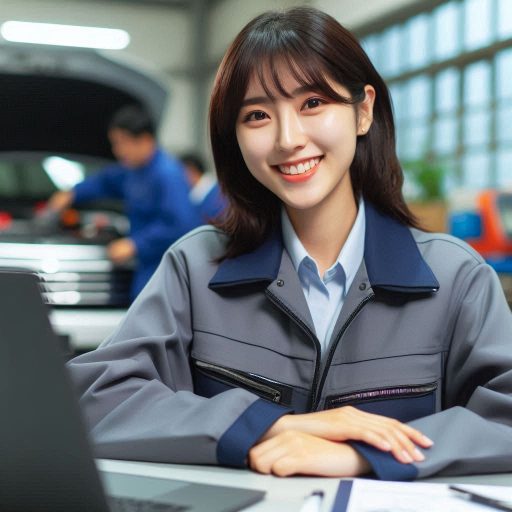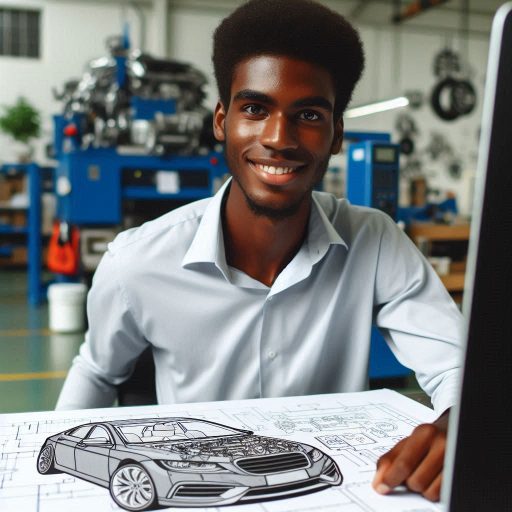Introduction
User interface design is crucial in modern cars.
A well-designed interface enhances driver experience and ensures safety.
As vehicles become more advanced, intuitive interfaces become essential.
Drivers need to interact seamlessly with various systems without distraction.
The automotive industry is rapidly evolving.
Technological advancements bring sophisticated infotainment systems, navigation tools, and driver assistance features.
This evolution demands user interfaces that prioritize usability and accessibility.
Drivers expect easy access to information, entertainment, and controls.
User-friendly interfaces reduce cognitive load.
They allow drivers to focus on the road while accessing essential functions.
Clear displays, responsive touchscreens, and voice controls contribute to a safer driving experience.
Poorly designed interfaces can lead to confusion and distractions, increasing the risk of accidents.
Modern cars often feature touchscreens that serve as the central hub for controls.
These screens must be strategically placed for easy visibility.
Additionally, the interface should allow for customization to cater to individual preferences.
Users appreciate personalization in their driving experience.
Moreover, voice recognition technology plays a significant role.
Drivers can issue commands without taking their hands off the wheel.
This hands-free interaction enhances safety and convenience.
However, voice commands must be accurate and responsive to be effective.
Transform Your Career Today
Unlock a personalized career strategy that drives real results. Get tailored advice and a roadmap designed just for you.
Start NowFurthermore, haptic feedback adds another layer of interactivity.
It provides tactile responses that confirm user actions, reducing uncertainty.
When drivers interact with controls, they appreciate immediate feedback on their input.
In summary, user interface design in modern cars is vital for safety and user satisfaction.
As technology evolves, designers must create intuitive, user-friendly interfaces.
These advancements will shape the future of automotive experiences, enhancing both functionality and enjoyment on the road.
Understanding User Needs‘
When designing user interfaces in modern cars, it is crucial to first understand the needs and preferences of car users.
This involves conducting thorough research to gather insights that will inform the design process.
Research on preferences and needs of car users‘
One of the key aspects of designing user interfaces for modern cars is to research the preferences and needs of car users.
This can be done through surveys, focus groups, and other user research methods.
Understanding what users want and need in their car interfaces is essential for creating a design that meets their expectations and enhances their driving experience.
For example, some users may prioritize ease of use, while others may value advanced features and customization options.
Consideration of safety features and accessibility requirements‘
Another important factor to consider when designing user interfaces in modern cars is safety features and accessibility requirements.
Safety should always be a top priority, and the design of the interface should not distract the driver or compromise their attention on the road.
Accessibility is also crucial, as the interface should be easy to use for all types of users, including those with disabilities.
This may require incorporating features such as voice commands, large buttons, and adjustable displays to accommodate different needs.
Importance of user-centered design in creating intuitive interfaces‘
User-centered design is the practice of designing products and services with the user in mind.
In the context of designing user interfaces for modern cars, this approach is essential for creating intuitive interfaces that are easy to use and understand.
By putting the needs and preferences of car users at the center of the design process, designers can create interfaces that are intuitive, user-friendly, and enjoyable to interact with.
This can lead to increased user satisfaction, improved usability, and enhanced overall driving experience.
Transform Your Career Today
Unlock a personalized career strategy that drives real results. Get tailored advice and a roadmap designed just for you.
Start NowRead: How to Network in the Automotive Design Field
Incorporating Technology in Modern Car Interfaces
Incorporating technology into user interfaces in modern cars enhances the driving experience.
This integration focuses on touchscreens, voice recognition, and gesture controls.
Integration of Touchscreens, Voice Recognition, and Gesture Controls
Touchscreens have become a staple in car interfaces.
They provide drivers with intuitive access to controls and information.
Voice recognition technology allows drivers to operate features hands-free.
This reduces distractions and keeps eyes on the road.
Gesture controls add another layer of convenience.
Drivers can adjust settings with simple hand movements.
Together, these technologies create a seamless user experience.
Implementation of Infotainment Systems and Connectivity Options
Infotainment systems are vital for modern vehicles.
They integrate navigation, music, and communication into one platform.
These systems often support smartphone connectivity through Apple CarPlay and Android Auto.
This allows drivers to access their favorite apps easily.
Reliable connectivity options, like Bluetooth and Wi-Fi, enhance user experience.
They enable real-time updates and remote diagnostics.
This connectivity fosters a more engaged and informed driving experience.
Balancing Technology with User Experience to Avoid Distractions
While technology improves functionality, it can also pose challenges.
Excessive features may overwhelm drivers and distract them from the road.
Designers must prioritize user experience when creating interfaces.
Transform Your Career Today
Unlock a personalized career strategy that drives real results. Get tailored advice and a roadmap designed just for you.
Start NowClear layouts and intuitive controls help prevent distractions.
Additionally, haptic feedback provides tactile responses, enhancing focus.
Testing and user feedback play crucial roles in refining interfaces.
Balancing technology with usability ensures safety and satisfaction for drivers.
In summary, incorporating technology into car interfaces is essential for modern vehicles.
Integration of touchscreens, voice recognition, and gesture controls enhances usability.
Infotainment systems and connectivity options offer entertainment and information.
By balancing technology with user experience, designers can create safe, engaging interfaces that benefit all drivers.
Read: 3D Modeling for Automotive Designers

Designing for Aesthetics in User Interfaces of Modern Cars
Importance of Visual Appeal in User Interface Design
Visual appeal plays a crucial role in user interface design.
A well-designed interface enhances user experience and engagement.
It creates an emotional connection between the driver and the vehicle.
Aesthetic interfaces can make technology feel more approachable and enjoyable to use.
This connection fosters brand loyalty and customer satisfaction.
When a car’s interface is visually appealing, it can transform mundane tasks into enjoyable experiences.
Consideration of Color Schemes, Fonts, and Graphic Elements
Color schemes, fonts, and graphic elements significantly impact user interfaces.
Designers must choose colors that evoke desired emotions while maintaining readability.
For example, cooler colors can convey a sense of calmness, while warmer colors can energize the driver.
Fonts should be legible and align with the car’s brand identity.
Graphic elements like icons and buttons should be intuitive and easy to recognize.
Transform Your Career Today
Unlock a personalized career strategy that drives real results. Get tailored advice and a roadmap designed just for you.
Start NowTogether, these components create an interface that is both functional and attractive.
Creating a Cohesive and Stylish Look That Complements the Car’s Overall Design
A successful user interface should harmonize with the car’s overall design.
Designers must consider the car’s materials, shapes, and styles when crafting interfaces.
A cohesive design creates a seamless experience for the user.
It also enhances the car’s aesthetics, making it more visually appealing.
By integrating the interface into the car’s design language, manufacturers create a more unified and luxurious feel.
Ultimately, this attention to detail elevates the overall driving experience.
Aesthetics play a vital role in user interface design for modern cars.
Designers must prioritize visual appeal, carefully consider color schemes and graphic elements, and ensure cohesion with the vehicle’s design.
By doing so, they enhance user experience and satisfaction, contributing to a successful and attractive automotive product.
Read: Storyboard Artist: From Concept to Finished Scene
Simplifying User Interaction
Streamlining menu layouts and navigation paths
Effective user interfaces in modern cars simplify interaction, ensuring drivers stay focused and safe.
Streamlining menu layouts and navigation paths is crucial for a smooth experience.
Designers must prioritize logical menu structures to allow users to quickly find what they need.
Simple and intuitive navigation paths reduce the time spent fumbling through options, enhancing usability.
Implementing clear and concise labels and instructions
Implementing clear and concise labels and instructions ensures that users can easily understand how to use the interface.
Labels should avoid jargon and use familiar terms to reduce confusion.
Well-placed instructions guide users through unfamiliar features without overwhelming them, improving the overall experience.
Minimizing cognitive load and ensuring ease of use for all users
Minimizing cognitive load is essential to ensure ease of use for all users, regardless of their familiarity with technology.
A cluttered interface distracts drivers, leading to frustration and potential safety risks.
Transform Your Career Today
Unlock a personalized career strategy that drives real results. Get tailored advice and a roadmap designed just for you.
Start NowSimplified designs keep interactions straightforward, allowing drivers to stay focused on the road.
The interface must balance functionality with simplicity to meet the needs of different users.
By streamlining layouts, providing clear labels, and reducing cognitive load, modern car interfaces become more user-friendly.
Each aspect contributes to an overall design that empowers drivers to interact with technology effortlessly.
These design strategies prioritize both safety and convenience, ensuring users can easily navigate their car‘s features.
As vehicles become more advanced, simplifying user interaction remains a critical design goal to enhance the driving experience and maintain driver attention where it matters most.
Read: Storyboarding Software: Best Programs to Use
Testing and Iteration
When it comes to designing user interfaces in modern cars, testing and iteration are crucial stages in ensuring that the end product is user-friendly and meets the needs of the drivers and passengers.
Here’s a detailed look at how testing and iteration play a significant role in the design process:
Conducting Usability Testing
One of the first steps in the testing phase is conducting usability testing with focus groups and real users.
This involves observing how users interact with the car’s interface, identifying any pain points or areas of confusion, and gathering feedback on their overall experience.
Gathering Feedback
After usability testing, it’s essential to gather feedback from users to understand their preferences, challenges, and suggestions for improvement.
This feedback can come from a variety of sources, including surveys, interviews, and user testing sessions.
Making Necessary Improvements
Based on the feedback received, designers can then make the necessary improvements to the interface.
This may involve adjusting the layout of controls, simplifying navigation menus, or changing the color scheme to enhance readability and usability.
Iterating on Design Iterations
Iterating on design iterations is an ongoing process that involves refining the interface based on user input and behavior analysis.
Designers may create multiple iterations of the interface, test each version with users, gather feedback, and make iterative improvements to create a final design that meets the user’s needs.
Therefore, testing and iteration are essential components of designing user interfaces in modern cars.
By conducting usability testing, gathering feedback, and iterating on design iterations, designers can create an intuitive and user-friendly interface that enhances the overall driving experience for users.
Learn More: Fashion Design: Importance of Pattern Making
Transform Your Career Today
Unlock a personalized career strategy that drives real results. Get tailored advice and a roadmap designed just for you.
Start NowFuture Trends in User Interface Design
As technology rapidly advances, the automotive industry is continuously evolving its user interface design in modern cars.
Let’s delve into some exciting future trends that are shaping the driving experience.
Exploration of Emerging Technologies‘
One of the most significant trends in user interface design for modern cars is the integration of augmented reality and artificial intelligence.
Augmented reality overlays digital information onto the physical world, providing drivers with real-time data without distracting from the road.
AI-powered voice assistants have also become increasingly common in cars, allowing drivers to control various functions using voice commands.
This hands-free approach enhances safety and convenience while driving.
Predictions for the Future‘
Looking ahead, we can expect to see more innovative features in in-car interfaces and interactive displays.
Touchscreens will become larger and more responsive, providing users with a seamless and intuitive experience.
Personalization will also play a crucial role in future user interface design, allowing drivers to customize their dashboard layout, display preferences, and even voice recognition settings.
This level of customization will cater to individual preferences and enhance user satisfaction.
Impact of Autonomous Vehicles‘
The rise of autonomous vehicles will undoubtedly revolutionize user interface design in modern cars.
With self-driving cars becoming more prevalent, the role of the driver will shift from actively controlling the vehicle to being a passenger.
This shift will enable designers to focus on creating entertainment and productivity features, as passengers will have more free time to engage with in-car interfaces.
Interactive displays may offer new entertainment options, such as watching movies or playing games, while on the road.
Furthermore, user interfaces in autonomous vehicles will need to prioritize safety and usability, ensuring that passengers can quickly and easily access essential information in emergencies or unexpected situations.
Designers will need to strike a balance between engaging features and ensuring a seamless and intuitive user experience.
All in all, the future of user interface design in modern cars is bright with the integration of emerging technologies, personalization options, and the impact of autonomous vehicles.
As we move towards a more connected and autonomous driving experience, user interface design will continue to play a crucial role in shaping the way we interact with vehicles on the road.
Conclusion‘
User interface design plays a critical role in modern vehicles.
It ensures a seamless interaction between drivers and technology.
Transform Your Career Today
Unlock a personalized career strategy that drives real results. Get tailored advice and a roadmap designed just for you.
Start NowA well-designed interface enhances driver safety, comfort, and overall satisfaction.
As technology continues to evolve, the demand for intuitive, easy-to-use interfaces grows.
Car manufacturers must prioritize designing interfaces that are accessible, responsive, and engaging.
To stay competitive, manufacturers need to put user experience at the forefront.
Prioritizing user-friendly interfaces allows drivers to focus more on the road and less on complicated controls.
This not only improves safety but also increases customer loyalty.
A smooth interface can set a brand apart in a crowded market.
User interface design directly impacts the driving experience.
When drivers feel connected to their vehicle‘s controls, they enjoy a more pleasant journey.
Advanced, intuitive designs reduce distractions and foster a stronger bond between drivers and their cars.
With every new vehicle model, the expectation for enhanced, innovative user interfaces rises.
In the end, designing effective user interfaces is essential to the success of modern cars.
Manufacturers should invest in research and development to create interfaces that address user needs.
This approach not only improves driving but also enhances the overall automotive experience.
As car technology advances, user interface design will continue to shape how people interact with their vehicles.
By focusing on user-friendly designs, car manufacturers can ensure a safer, more enjoyable driving experience for all.




